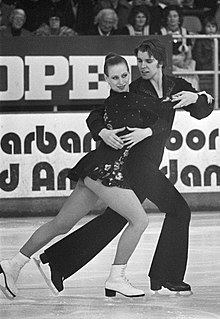Ice dance

|
|
| Highest governing body | International Skating Union |
|---|---|
| Characteristics | |
| Team members | Duos |
| Mixed gender | Yes |
| Equipment | Figure skates |
| Presence | |
| Olympic | Part of the Winter Olympics from 1976 (demonstration event in 1968) |
Ice dancing is a discipline of figure skating that draws from ballroom dancing. It joined the World Figure Skating Championships in 1952, and became a Winter Olympic Games medal sport in 1976.
As in pair skating, dancers compete as a couple consisting of a man and a woman. Ice dance differs from pair skating by having different requirements for lifts. Couples must perform spins as a team in a dance hold, and throws and jumps are disallowed. Typically, partners are not supposed to separate by more than two arm lengths. Originally, partners were supposed to be in a dance hold the entire program, though modern ice dancing has lifted this restriction somewhat.
Another distinction between ice dance and other skating disciplines is the use of music in the performances. In ice dancing, dancers must always skate to music with a definite beat or rhythm. Singles and pair skaters more often skate to the melody and phrasing of their music, rather than its beat. This is severely penalized in ice dance.
In some non-ISU competitions, solo dancers may also compete.
There are two segments in ice dance competitions: the short dance (SD), and the free dance (FD). The free dance is the most heavily weighted in the scoring and is used as a tiebreaker. Until the end of the 2009–10 season, competitions included one or more compulsory dances (CD), an original dance (OD), and the free dance.
In compulsory dances, all dance teams in a competition perform the same standard steps and holds to music of a specified tempo. One or more compulsory dances were skated as the first phase of competitions in ice dancing, but they are also popular as a form of recreational or social dance among skaters. The patterns for most dances either cover one-half or one full circuit of the rink. The International Skating Union (ISU) would publish the compulsory dances that would be performed prior to each season, and CDs were later drawn for specific events.
The compulsory dance was discontinued in all ISU competitions after the 2009–2010 season. The 2010 World Championships were the last event to include a CD (the Golden Waltz), and Italians Federica Faiella / Massimo Scali were the last dance team to perform one in competition.
...
Wikipedia
